
The sharpest image yet of a red giant star: 320 light years from Earth, the star W Hydrae is a few billion years further on than the Sun in its life. For comparison, the dotted ring shows the size of the Earth’s orbit around the Sun, seen from an angle. Alma is sensitive to submillimeter wavelengths; this image is taken at around 0,9 mm. Credit: Alma (ESO/NAOJ/NRAO)/W. Vlemmings
For the first time, astronomers have observed details on the surface of an aging star with the same mass as the Sun. The new ALMA images show that the star is a giant, with a diameter twice the size of Earth’s orbit around the Sun. It also reveals that the star’s atmosphere is affected by powerful, unexpected shock waves.
A team of astronomers led by Wouter Vlemmings, Chalmers University of Technology, have used the telescope Alma (Atacama Large Millimeter/Submillimeter Array) to make the sharpest observations yet of a star with the same starting mass as the Sun. The new images show for the first time details on the surface of the red giant W Hydrae, 320 light-years distant in the constellation of Hydra, the Water Snake.
W Hydrae is an example of an AGB (asymptotic giant branch) star. Such stars are cool, bright, old, and lose mass via stellar winds. The name derives from their position on the famous Hertzsprung-Russell diagram, which classifies stars according to their brightness and temperature.
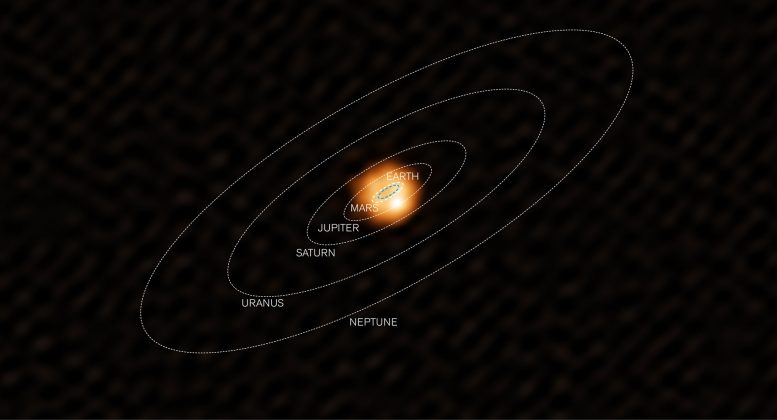
The sharpest image yet of a red giant star: 320 light years from Earth, the star W Hydrae is a few billion years further on than the Sun in its life. The dotted rings show the size of the orbits of the Earth (in blue) and other planets around the Sun for comparison. The system is seen at an angle. Alma is sensitive to submillimeter wavelengths; this image is taken at around 0,9 mm. Credit: Alma (ESO/NAOJ/NRAO)/W. Vlemmings
– For us it’s important to study not just what red giants look like, but how they change and how they seed the galaxy with the elements that are the ingredients of life. Using the antennas of Alma in their highest-resolution configuration we can now make the most detailed observations ever of these cool and exciting stars, says Wouter Vlemmings.
Stars like the Sun evolve over timescales of many billion years. When they reach old age, they puff up and become bigger, cooler, and more prone to lose mass in the form of stellar winds. Stars manufacture important elements like carbon and nitrogen. When they reach the red giant stage, these elements are released into space, ready to be used in subsequent generations of new stars.
Alma’s images provide the clearest view yet of the surface of a red giant with a similar mass to the Sun. Earlier sharp images have shown details on much more massive, red supergiant stars like Betelgeuse and Antares.
The observations have also surprised the scientists. The presence of an unexpectedly compact and bright spot provides evidence that the star has surprisingly hot gas in a layer above the star’s surface: a chromosphere.
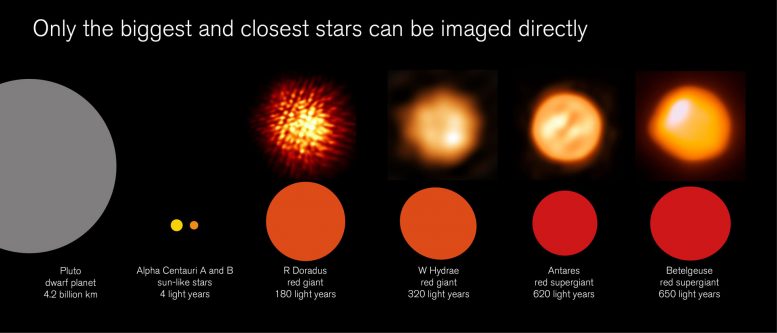
Direct imaging of even the biggest and closest stars, is a challenge for astronomers. In this graphic, the Alma image of W Hydrae is compared with the best images so far of other stars: the red giant R Doradus, the red supergiants Antares and Betelgeuse. A variety of imaging techniques and different wavelengths of light have been used to create these images; giant stars can have very different sizes seen in different wavelengths. The angular sizes of the stars in Alpha Centauri, the closest star system, and the dwarf planet Pluto (at its closest to Earth) are shown for comparison. Credit: ESO/K. Ohnaka (Antares); Alma (ESO/NAOJ/NRAO)/E. O’Gorman/P. Kervella (Betelgeuse); ESO (R Doradus); Alma (ESO/NAOJ/NRAO)/W. Vlemmings (W Hydrae)
– Our measurements of the bright spot suggest there are powerful shock waves in the star’s atmosphere that reach higher temperatures than are predicted by current theoretical models for AGB stars, says Theo Khouri, astronomer at Chalmers and member of the team.
An alternative possibility is at least as surprising: that the star was undergoing a giant flare when the observations were made.
The scientists are now carrying out new observations, both with Alma and other instruments, to better understand W Hydrae’s surprising atmosphere. Observations like these with Alma’s highest-resolution configuration are challenging, but also rewarding, explains team member Elvire De Beck, also astronomer at Chalmers.
– It’s humbling to look at our image of W Hydrae and see its size compared to the orbit of the Earth. We are born from material created in stars like this, so for us it’s exciting to have the challenge of understanding something which so tells us both about our origins and our future, she says.
Reference: “The shock-heated atmosphere of an asymptotic giant branch star resolved by ALMA” by Wouter Vlemmings, Theo Khouri, Eamon O’Gorman, Elvire De Beck, Elizabeth Humphreys, Boy Lankhaar, Matthias Maercker, Hans Olofsson, Sofia Ramstedt, Daniel Tafoya and Aki Takigawa, 30 October 2017, Nature Astronomy.
DOI: 10.1038/s41550-017-0288-9

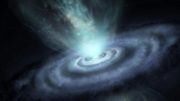
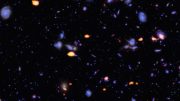
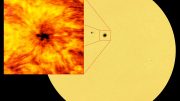
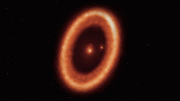
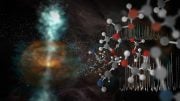

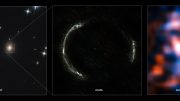
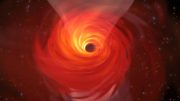
Be the first to comment on "New ALMA Image Provides a Surprising Glimpse of Our Sun’s Future"